March 16, 2018
On our second full day in Villahermosa, our friends picked us up for a 90-mile drive to what in my opinion is the best of all the Latin American pre-Columbian sites: Palenque. Well, at least it is the best of the ones I have seen. I had been there in 1979, and I remembered that walking around it felt like walking in a movie set (which is a little strange--something real feeling like something fictional).
The walk between the parking lot and the ruins was lined with vendors, which was good because Bob really needed a hat. We were facing another day of almost 100° weather and over 90% humidity. A hat won't help with the humidity, but a little shade on the head is a good thing, and this shopkeeper seemed especially happy to make the sale.
Tropical climate makes for bodily misery, but it also creates a beautiful setting.
The region was first inhabited by Mayans in about 200 BC, with Palenque's glory days beginning at about 200 AD when it was a power center that ruled over the region. For unknown reasons, Palenque was abandoned by its residents in 900 AD, leaving its temples, palaces, and homes to be gobbled up by the hungry jungle.
The first "modern" account of the city was published in 1567 by Father Pedro Lorenzo de la Nada, the Spaniard who initially ran across the ruins and named them "Palenque," or "fortification" in Spanish. No more official visits were made until the late 18th century. Many archaeologists visited the area throughout the 19th century, but it wasn't until 1891 that the first excavations and restorations began. Palenque was named a UNESCO World Heritage Site in 1987 and is now one of the most visited archaeological sites in Mexico.
Okay, let's head on in. Here is some background music to enhance your viewing pleasure.
First up: Temple of the Skull, the first structure tourists usually see as they enter the grounds.
All of the buildings are made of local limestone with lintels of wood and decorated with stucco sculpture and bas-relief carvings. Most of them were brightly painted by their creators.
This is the iconic photo of Palenque: The Palace. It was probably the ceremonial and administrative center during the city's heyday.
Here is a photo I took of the same building seen from a slightly different angle 39 years earlier when I was a student in Mexico.
And back to 2018, here it is again from another direction. You can see how the jungle is creeping up on the ruins.
The iconic four-level 82-foot-tall tower was built around 721 by one of Pakal's sons who succeeded him.
The palace is a dense and complex assemblage of rooms, courtyards, hallways, and staircases.
One of the open spaces is El Patio de los Cautivos, or Courtyard of the Captives. This is where those captured in war were exhibited in front of the palace nobles before being sacrificed.
Exquisite bas relief limestone carvings of some of the prisoners line the courtyard.
Other bas relief carvings are found in other places around the site.
The palace also has a network of above ground and subterranean passageways:
To the left of the Palace in the photo below is the Temple of the Inscriptions, perhaps the most important building on the site.
This picture (taken with a Vivitar instamatic camera) is from my scrapbook of my 1979 visit. I wrote the caption: "My favorite of the pyramids."
The stairs going up are very steep.
Ruiz described what he saw when he shined his flashlight into the darkness:
"Out of the dim shadows emerged a vision form a fairy tale, a fantastic, ethereal sight from another world. It seemed a huge magic grotto carved out of ice, the walls sparkling and glistening like snow crystals. Delicate festoons of stalactites hung like tassels of a curtain, and the stalagmites on the floor looked like drippings from a great candle. The impression, in fact, was that of an abandoned chapel. Across the walls marched stucco figures in low relief. Then my eyes sought the floor. This was almot entirely filled with a great carved stone slab, in perfect condition."
Inside the tomb, Ruiz and others found Pakal's jade death mask, other jade heads, five skeletons at the entrance that were probably sacrificial victims, and many other artifacts.
 |
| Pakal's funerary mask, on display at the National Museum of Anthropology in Mexico City in a recreation of his tomb (which I think we missed seeing). |
The great stone slab Ruiz notes is a carved stone sarcophagus lid that measures about 7 feet by 12 feet and weighs 7 tons. It would never fit down the stairways that lead to the tomb, so it is believed the tomb was created and the sarcophagus was sealed before the pyramid was built around it. It is still down there to this day because they still can't fit the slab through the narrow passage of the stairway. The carvings give details about Pakal's life and lineage, but the important image shown below (left) is of Pakal being reborn as a god and lifted to the heavens. The photo on the right is one that I took myself of the lid in June 1979. I can't believe that they let us down into the tomb back then! I don't think that is happening now.
Another discovery in the temple-tomb was thirteen corbeled roof sections connecting the tomb to an upper chamber, representing the thirteen levels of the Mayan concept of heaven. Altogether, then, the pyramid shows Pakal's descent through the nine levels of the underworld and then ascent through the thirteen levels of heaven to reach divine status.
This discovery finally proved that the spectacular Mayan pyramids were not just temples, but were also tombs for great rulers, just as they were in ancient Egypt.
 |
| Happy travelers in our matching wide-brimmed hats, 2018 |
 |
| The perfect place for a photograph |
Looking around, it was not hard to imagine this site completed hidden by the trees and bushes.
This is the Temple of the Cross, the main temple in the Cross Complex of three temples. Each temple honors a different set of Palenque's gods. The Temple of the Cross was also built to commemorate the ascension to the throne of Pakal's successor.
I decided I want to climb to the top:
The second temple in the Cross Complex is the Temple of the Sun.
There are many structures sprinkled throughout the Palenque site that are smaller and not as well restored as the main temples and buildings already discussed.
Nothing here is ADA compliant. There are stairs, stairs, and more stairs.
Some of the temples have fairly well-preserved murals inside. This one is from Temple IV.
The Mayans were pretty savvy city planners. There seem to be plenty of wide-open spaces.
This is the Temple of the Count, so named because a French count, Jean-Frédéric Waldeck, lived inside it from May 1832 to July 1833, supposedly with his Mayan mistress. Dating to 640 AD, it is the oldest excavated building so far.
We also stopped at this beautiful waterfall, Misol-Ha, a single cascade with a 115-foot drop.
We got a kick out of the sign that read: "Caution Dear Tourists, you inform you that be careful to swim in the poza [pool]. It is reaching and a depth of 25 meters. Take precautions to getting into the poza. 1. It is forbidden to swim whit heavy clothing and shoes. 2. Do not take food or alcoholic drinks. 3. If going to swim wear light clothes. 4. Use lifejackets if is at your own risk." The words in Spanish at the bottom, Cuidemos el medio ambiente, mean "Let's take care of the environment!"
It appears to be a popular place to get wet. The blue-green water has a high mineral content.


A 65-foot-long cave behind the falls has a nice footpath that allowed us to cool down without getting too wet.
We also stopped in the city of Palenque, located about 4 miles from the archaeological site and one of Mexico's 121 (as of October 2019) pueblos magicos, or magical towns. With a population of about 110,000, is is much more than a village, but there isn't too much to do here. People mostly use it as a base from which to visit the ruins.









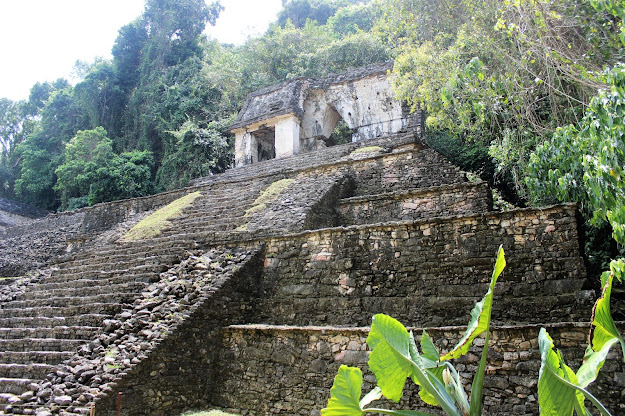




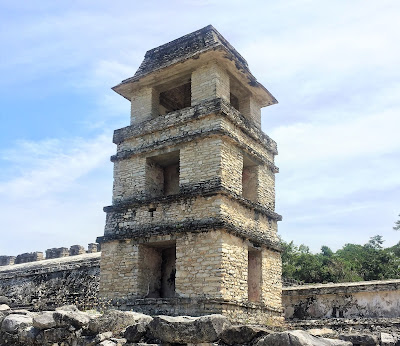
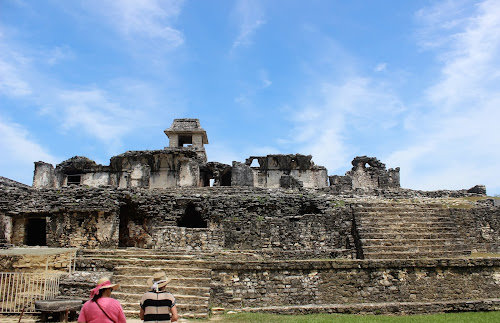

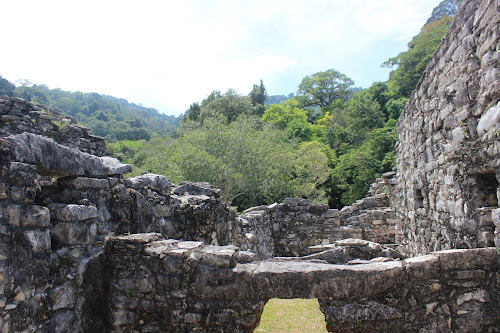

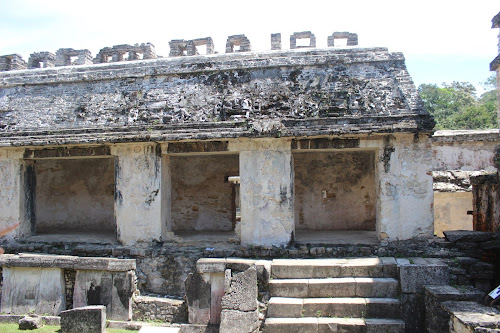












































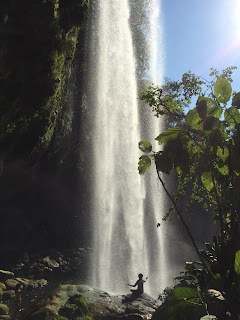
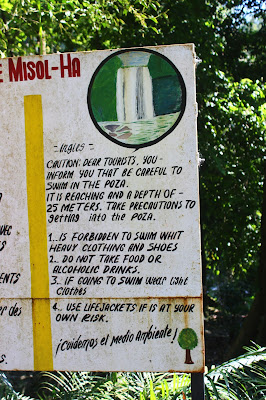




An amazing place. Fun to have your old experiences thrown in. Wouldn't it be amazing to be able to view life back then.
ReplyDeletewow, I didn't realize they used to let tourists into the tomb of Pakal. I wish I could have seen that. I one day hope to get out to Palenque
ReplyDelete